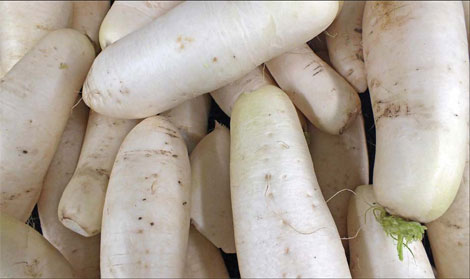Soothing winter radishes
Updated: 2012-02-10 09:36
By He Juling (何菊玲) (China Daily)
|
||||||||
|
White radish is called "little ginseng" among the Chinese people because of its many benefits. [Liu Junfeng / For China Daily] |
Healing qualities of vegetable lauded since ancient times
The restorative and cooling properties of the resplendent white radish are the stuff of Chinese folklore, earning it the nickname "little ginseng". Their healing qualities are also proclaimed by that most inarguable of assurances, the ancient Chinese saying: "When white radishes are in season, doctors should take a break." (萝卜上市,郎中下岗; Luóbo shàngshì, lángzhōng xiàgǎng). For those looking for something with a little more authority, the Compendium of Materia Medica, a Ming Dynasty (1368-1644) text written by the acclaimed medical researcher Li Shizhen (李时珍, lǐ shí zhēn), says simply that "white radishes are the most beneficial vegetable to human bodies" (蔬中最有利者, shū zhōng zuì yǒulì zhě).
The good news is that white radish, characterized by its watery texture and earthy aroma, is one of the most widely available and cheapest winter vegetables in China. Moreover, they are the perfect addition to lamb or beef stew, and can also be stir-fried or turned into a tasty cold dish with just a sprinkle of salt or sugar. For those in a rush, they are not bad eaten raw, either.
Their popularity is part a consequence of their role as a counterpoint to the huge quantities of meat most people eat over the winter months in order to maintain energy and keep warm. The buildup of all this high-calorie meat in the body, and the high likelihood that people will find ways to avoid taking the exercise needed to work it off, leads to an accumulation of internal heat for which white radishes are the perfect remedy. For those living in North China and other dry regions, they also help provide much needed water to help with rehydration.
Modern scientific research has also shown that white radishes are rich in mustard oil, diastase and coarse fiber, which can help improve digestion, stimulate the appetite and accelerate gastrointestinal motility. In other words, white radishes help break up and digest the tough and fibrous meat.
One legend goes that the monks of Dinghui Temple (定慧寺) in the city of Rugao (如皋), Jiangsu province, began to grow white radishes in the Tang Dynasty (AD 618-907) and regarded them as worthy of including in offerings to the gods. Sometimes they also presented the white radishes to local people as a kind of medicine. As time went by, the word-of-mouth tales of their attributes helped the vegetable spread across China.
Even today the white radishes grown in Rugao are said to be the best in China, as the climate and sandy soil provide the perfect conditions for their growth. Rugao white radishes are renowned for their thin skin, tender pulp, juiciness and sweet but non-spicy flavor. Look out for dried and pickled Rugao white radishes (如皋萝卜干, rúgāo luóbogān), which are hugely popular for their tender, sweet and crispy taste.
Stories are courtesy of The World of Chinese, www.theworldofchinese.com

 Relief reaches isolated village
Relief reaches isolated village
 Rainfall poses new threats to quake-hit region
Rainfall poses new threats to quake-hit region
 Funerals begin for Boston bombing victims
Funerals begin for Boston bombing victims
 Quake takeaway from China's Air Force
Quake takeaway from China's Air Force
 Obama celebrates young inventors at science fair
Obama celebrates young inventors at science fair
 Earth Day marked around the world
Earth Day marked around the world
 Volunteer team helping students find sense of normalcy
Volunteer team helping students find sense of normalcy
 Ethnic groups quick to join rescue efforts
Ethnic groups quick to join rescue efforts
Most Viewed
Editor's Picks

|

|

|

|

|

|
Today's Top News
Chinese fleet drives out Japan's boats from Diaoyu
Health new priority for quake zone
Inspired by Guan, more Chinese pick up golf
Russia criticizes US reports on human rights
China, ROK criticize visits to shrine
Sino-US shared interests emphasized
China 'aims to share its dream with world'
Chinese president appoints 5 new ambassadors
US Weekly

|

|








